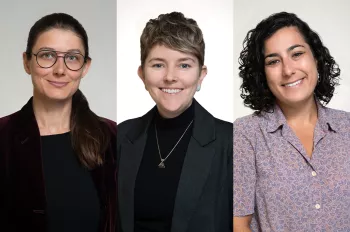The Base of a Good Diet: Precision Health Study Makes Headway Two Years In

What’s the best diet? Are eggs good or bad for you? Are carbs the enemy? How much red meat and dairy should you be eating?
For ages, questions such as these that involved personal nutrition have persisted—with seemingly ever-changing guidance on what foods are in and what foods are out. A five-year, $200 million study funded by the National Institutes of Health called The Nutrition for Precision Health is poised to give artificial intelligence the opportunity to deliver nutrition plans on a person-by-person basis.
Illinois Institute of Technology is one of 14 institutions that make up the six main centers in the consortium. Illinois Tech researchers are paired with Northwestern University and the University of Chicago to make up the Illinois Center.
The goal? Study, monitor, and assess the diets of 9,000 people, collect biospecimens and analyze them to gather as much data as possible about people’s metabolic response to their usual diet and a test meal. Data are compiled into a centralized database, where colleagues at West Point and City University of New York will use AI and machine learning techniques to generate predictive modeling algorithms that will unveil diet-specific information so the right diet can be advised on an individual level.
“With the amount of detailed data we will have on people under different conditions, we will be in a position to develop virtual people based on real people’s dietary responses to test diet-related hypotheses,” says Britt Burton-Freeman, director of Illinois Tech’s Center for Nutrition Research and professor and chair of the university’s Department of Food Science and Nutrition. “AI can run simulations to understand how these virtual people respond to different dietary patterns, which will provide insight for individualized recommendations. The next phase of this research will be to validate the algorithms.”
The study is broken up into three modules—Illinois Tech is gathering data for modules one and two. In each module, participants’ diets are monitored for a set period of time—10 days for module one and three, two-week diet periods for module two where people receive a calorie customized diet plan to maintain weight from the Center for Nutrition Research’s Metabolic Precision Nutrition Production Kitchen—followed by a visit to the Center for Nutrition Research at the end of each diet period. There, they’ll eat a standardized, but individualized test meal, and data about their metabolic response to that meal is then gathered, analyzed, and finally sent to the larger database.
“We monitor what people do during the day by various means—we monitor heart rate and their activity level using research watches and heart straps, we monitor their glucose concentrations using a continuous glucose monitor, they answer surveys for us,” says Burton-Freeman. “We do a variety of things to understand who they are and the life they lead while following specific NPH diets.”
The main difference between the two modules is that, in module one, participants eat their normal diet. In module two, participants are provided with everything they’ll eat during the duration of that part of the study.
One of the monumental challenges of this work is providing the exact same meal for every single participant.
“Who’s making all that food for Illinois participants? Illinois Tech is,” says Burton-Freeman. “We have a metabolic production kitchen that we’ve stood up to feed all the people in the Illinois clinical center, which includes people who see us at Illinois Tech, Northwestern, or University of Chicago. That is something we specifically are doing to cover this entire region. All participants get the same meals customized for weight maintenance, whether they’re here in Illinois, California, Alabama, Boston.”
After data from all 9,000 participants has been gathered and analyzed, Burton-Freeman anticipates that people will fall into certain categories or clusters, depending how their body responds.
“We might have a cluster of people, for example, that respond in an exaggerated way to a meal with their glucose response, and others will be moderate,” says Burton-Freeman. “We expect to have several different clusters of people within a similar dietary pattern. These clusters of people across several different ways people eat in America—aka dietary pattern—provides insights to the relationship of dietary pattern and healthy physiological functions of the body.”
By learning how a person within a defined cluster responds to the test meal, AI will ultimately be able to create a personalized nutrition plan that should be healthiest for them. By analyzing nutrition to the precision of an individual, Burton-Freeman hopes to find scientific evidence that can help explain why some people live more than a century eating a high-carbohydrate diet, for example, while others can barely tolerate a single slice of toast.
Now in the second year of the five-year program, about 25 percent of the data has been collected. Burton-Freeman and her colleagues at the Center for Nutrition Research are focused on reaching the 9,000-participant mark with other Centers around the United States. After that, there will likely be a verification stage of the project, where the predictions made by AI will be put to the test.
“This is discovery science so we’ll see what we learn. Perhaps though, there will be a day you drink a simple beverage we give you,” says Burton-Freeman. “Then, after taking a few blood samples, and having them analyzed, we’ll plug your data into a model and out reads the best diet for you to address your issue or achieve your health goal.”
Photo by Vincent Alban




